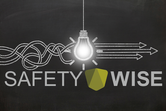“S is for Safety. S, S, S…”

Kindergarten Learning
My youngest child, Ellie Grace, started Kindy (otherwise known as Prep) in primary school this year. I’m happy to say that she absolutely loves it and has embraced the learning curriculum with avid enthusiasm. With my boys Jacob and James now in Years 6 and 7 respectively, it’s been a long time since I thought about how they learnt to recognise words and start reading so I’m having to learn all over again the methods used to support Ellie’s learning.
Ellie has been bringing home “sight words” every week. These are words that the children have to learn by sight as opposed to sounding them out. The other method of learning involves a concept called “Sound Waves”. This approach focuses on learning about the sounds each letter makes and the children are taught a little chant focusing on the sound of letters such as “A is for apple, A,A,A” and “B is for balloon, B,B,B”.
Parents are encouraged to let the child identify items in their home and social environment and work out the letter the items start with through sounding it out, and then referencing that item in a chant. Now, this is all sounds like fun and games, until you take your child food shopping at Woolworths and what used to take you one hour now turns into a two hour painfully, slow exercise as Ellie merrily skips down the aisles, finding items then stopping to sing “B is for banana, B,B,B”, M is for milk, M, M,M”.
Safety as a Core Curriculum Topic?
Along with spelling, literacy and mathematic concepts, Kindergarten has taught Ellie a wide range of other curriculum topics. But as a Safety Professional and Accident Investigator, I can’t help but wonder if our education departments should introduce a core curriculum topic of Safety.
A few years back I presented a paper at the QLD Mining Conference about the skills shortage and my concern that several significant incidents at that time had involved young workers, who had transitioned from a protected school environment into heavy industries… and for some of them, within a matter of months, they paid the ultimate price of clearly not understanding the importance of safety concepts and they were involved in significant incidents.
During interviews, when they were asked simple questions such as “Had you seen or read the procedure for that task?” or “Did you go through the pre-start that shift?” or “Did you read the risk assessment for that operation?” – I have to say that most of the young workers knew the boxes they had to tick or the places they had to sign… but admitted to not actually reading or fully comprehending the associated document.
Safety – just as important as ABC’s
My thoughts are at what point do we as a society recognise that teaching a child safety concepts and appreciation is just as important as teaching them their ABC’s in school ? The first time our young workers in a safety critical environment hear the acronyms WHS, OHS, SMS, JSA, HSR, ALARP etc. shouldn’t be during a quick induction. In my opinion, safety and the associated concepts in an applied environment is something that should be introduced at a young age. It should not come as a surprise to a young worker that they have to “do all this safety stuff” when they commence work.
Just as they leave the school environment, hopefully having a sound grasp of english, mathematics etc. my vision is that our young ones should leave the school environment having a fundamental understanding of safety in an applied environment. Is it time for a shake up to think about the core topics our children should be learning at school? At the end of the day, some current topics may be of use to some students after leaving school, dependent on their chosen career path. But for all children, knowing the inherent importance of a JSA may actually save their life one day…
So, as Ellie walked around the house chanting “S if for seal. S, S,S” last week – all I could think is how good it would be to hear her singing “S is for safety. S.S.S” and knowing a core topic introduced at school, even to our little five year olds, would be Safety.
Interested in Knowing More?
Further information on Safety Wise’s Incident Cause Analysis (ICAM) Training is available from our website: http://www.safetywise.com/
Additional ICAM Related Services
Safety Wise also offers the following additional services for sites that adopt the ICAM investigation analysis method:
Quality review of incident investigations using ICAM
Trend analysis of organisational factors contributing to serious incidents
Participation in investigations as an external / independent party
Jo De Landre




